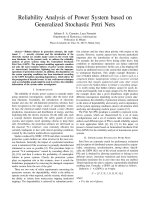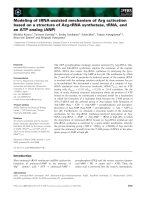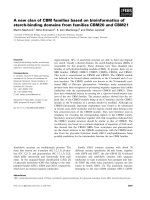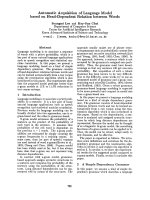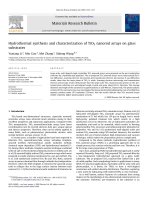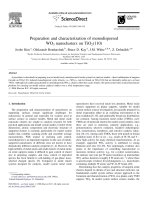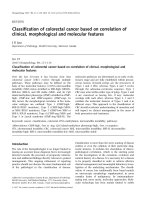Characterization of winged bean based on molecular markers
Bạn đang xem bản rút gọn của tài liệu. Xem và tải ngay bản đầy đủ của tài liệu tại đây (316.49 KB, 7 trang )
Vietnam Academy of Agricultural Sciences (VAAS)
Japonica type and Indica type rice varieties. eor
Appl Genet, 104: 1-8.
Unnevehr LJ, 1992. Methodologies for measuring
consumer preferences and welfare e ects of quality
improvement. Comsumer demand for rice grain
quality. (pp. 21-33). International rice research
Insitute.
Wanchana S, Tragoonrung S, Toojinda T, Vanavichit A,
2003. Duplicated coding sequence in the waxy allele
of tropical glutinous rice (Oryza sativa L.). Plant Sci,
165(6): 1193-1199.
Wang ZY, Zheng FQ, Shen GZ, Gao JP, Snustad DP,
Li MG, Zhang JL, Hong MM, 1995. e amylose
content in rice endosperm is related to the posttranscriptional regulation of the waxy gene. Plant J,
7(4): 613-622.
Zhou, Lei, Chen S, Yang G, Zha W, Cai H, Li S, Chen Z,
Liu K, Xu H, You A, 2018. A perfect functional
marker for the gene of intermediate amylose content
Wx in rice (Oryza sativa L.). Crop Breeding and
Applied Biotechnology, 18: 103-109.
Date received: 12/10/2018
Date reviewed: 21/10/2018
Reviewer: Dr. Nguyen Anh Vu
Date approved for publication: 25/10/2018
CHARACTERIZATION OF WINGED BEAN
BASED ON MOLECULAR MARKERS
Tran Quang Dieu1, Dodake S. S.2, Nguyen Xuan
ang*1
Abstract
Twenty winged bean genotypes received from All India Co-ordinated Research Network on Potential Crop,
Department of Agricultural Botany, MPKV, Rahuri, MS, India were sown and used for assessment of molecular
polymorphism, diversity analysis by 11 ISSR primers. All primers successfully ampli ed polymorphism regions,
as among 124 bands position, 76 polymorphic regions (61.3%) were ampli ed. Accordingly, highest and lowest
similarities among genotypes were measured as 98% and 72% respectively. e results based on UPGMA method
also categorized all genotypes into four main groups. e genetic distance based on the ISSR markers indicated the
close relationship and narrow genetic background between winged bean accessions.
Keywords: Winged bean, characterization, molecular marker, polymorphism
INTRODUCTION
Winged bean or Goa bean [Psophocarpus
tetragonolobus (L.) DC.] is a tropical legume found
growing abundantly in hot, humid equatorial
countries like India, Burma, Sri Lanka, ailand and
the Philippines. It has the high protein content in the
seeds and therefore considered as a versatile legume
and grown as a grain legume, green vegetable, tubercrop or a forage and cover-crop.
Knowledge of genetic diversity within and among
genotypes of any crop is fundamental to estimate the
potential of genetic gain in breeding programs and
for e ective conservation and sustainable utilization
of available genetic resources (Sakiyama, 2000). e
presence of genetic diversity is crucial for improving
the quality of any plant species. An understanding
of the magnitude and pattern of genetic diversity in
crop/forestry plants has important implications in
breeding programs and for conservation of genetic
resources (Charu et al., 2013).
1
*
Molecular marker tools provide valuable data on
diversity through their ability to detect variation at
the DNA level. Molecular markers have emerged as a
fascinating technology for evaluating genetic diversity
(Naik et al., 2017; Wong et al., 2017), vegetable
(leaves and pods); genetic structure variation and
ngerprinting (Shanjani et al., 2009).
Several DNA based molecular markers are now
currently used in diversity study of plants. Amongst
them inter simple sequence repeat (ISSR) markers are
commonly used to characterize the genetic diversity
of crop plants and can be immensely helpful in
identifying the potential elite genotypes. e utility
of this marker as a potential tool for documenting
the genetic variations in several legume crops like
Chickpea (Collard et al., 2003); Groundnut (Mondal
et al., 2009)115 were found Arac his h ypogaea L.;
Cluster bean (Pathak et al., 2010); Mung bean and
Black gram (Tantasawat et al., 2010) cluster III
containing 4 Thai cultivated blackgram varieties,
and cluster II containing a mungbean wild relative
Maize Research Institute of Vietnam; 2 Mahatma Phule Krishi Vidyapeeth, Rahuri, MS, India
Corresponding author: Nguyen Xuan ang. Email:
12
Journal of Vietnam Agricultural Science and Technology - No.1(3)/2018
(subspecies sublobata. However, no such reports on
genetic diversity assessment studies using molecular
markers separately are available in winged bean. us,
in the present study, ISSR marker was used to evaluate
the extent of genetic diversity among 20 winged
bean genotypes and their e ciency in analyzing
the genetic variations will be compared to estimate
genetic diversity and establish a genetic relationship
among winged bean genotypes using ISSR marker.
MATERIALS AND METHODS
Materials
A set of 20 winged bean genotypes received from Plant
Breeder, All India Co-ordinated Research Network on
Potential Crop, Department of Agricultural Botany,
MPKV, Rahuri was sown and used for assessment of
molecular polymorphism, diversity analysis.
Table 1. List of genotypes winged bean used in present study
Sr. No.
1
2
3
4
5
6
7
8
9
10
11
12
13
14
15
16
17
18
19
20
Genotype
IC-95221
EC-27885
EC-38821
EC-121921
EC-142653
EC-142661
EC-142666
EC-142667
EC-178268
EC-178269
EC-178291
EC-178310
EC-178311
EC-178317
EC-178318
EC-178319
EC-178332
EC-198327
EC-251020
EC-178331
Country
India
Ghana
Papua New Guinea
Indonesia
Indonesia
Indonesia
Indonesia
Indonesia
ailand
ailand
ailand
ailand
ailand
ailand
ailand
ailand
ailand
NA
NA
ailand
Method
DNA Extraction
Young leaves from each accession was ground in
liquid nitrogen to a ne powder and total genomic
DNA was extracted using CTAB method described
by Aljanabi et al. (1999) with some modi cations.
Yield and purity of genomic DNA were estimated
at OD260/280 on spectrophotometer. e integrity of
genomic DNA was determined by running the DNA
on 0.8% agarose gel.
ISSR analysis
A total of 11 ISSR primers were selected and used
for PCR ampli cation of the genomic DNA samples
(Table 2).
Seed color
Red Brown
Light Brown
Light Brown
Light Brown
Light Brown
Light Brown
Light Brown
Light Brown
Light Brown
Light Brown
Light Brown
Light Brown
Light Brown
Dark Brown
Light Brown
Light Brown
Light Brown
Light Brown
Light Brown
Dark Brown
Seed shape
Spherical
Spherical
Spherical
Round
Round
Round
Spherical
Spherical
Spherical
Round
Round
Round
Spherical
Spherical
Spherical
Spherical
Spherical
Spherical
Spherical
Spherical
e ISSR reaction mixture (total volume = 20 µl)
contained 50 ng DNA, 10X PCR bu er, 25 pM
primer, 2.5 mM of dNTPs mix, 25 mM MgCl2, and
3 unit Taq DNA polymerase (Genei, India). An
initial, preheating step (5 mins at 94oC) was carried
out in order to achieve a hot start. Subsequently, a
touchdown (TD) procedure (35 cycles) was carried
out that consisted of denaturation at 94oC for
1 min, annealing in 1 min at di erent temperature
depends on primer and extension at 72oC in 1 min.
A er the last cycle, an extension step of 72oC for
10 min was performed. e ampli ed products were
electrophoresed on 1.5% agarose gels and observed
under UV trans illuminator in gel documentation
system (Gel Logic 1500 imaging system) and images
were captured.
13
Vietnam Academy of Agricultural Sciences (VAAS)
Table 2. Primer sequences used for ISSR
Sr. No.
Primers name
1
2
3
4
5
6
7
8
9
10
11
ISSR-8932801
ISSR-8932802
ISSR-8932803
ISSR-8932804
ISSR-8932806
ISSR-8932807
ISSR-8932808
ISSR-8932809
ISSR-8932811
ISSR-8932812
ISSR-8932815
Sequences of primers
(5’ - 3’)
AGCAGCAGCAGCAT
CACACACACACAAT
CACACACACACAAC
CACACACACACAGT
CACACACACACAGA
CACACACACACAAA
GTGTGTGTGTGTTA
GTGTGTGTGTGTTG
GTGTGTGTGTGTCT
CAGGAGAGAGAGAGA
GCTGAGAGAGAGAGA
Data analysis
e binary data scored was used to calculate the
similarity genetic distance using Simqual sub
programme of NTSYS-pc 2.1 so ware [Numerical
Taxonomy and Multivariate Analysis System
Programme (Rohlf, 2004)]. Dendrogram was
constructed by using distance matrix by the
unweighed pair group method with arithmetic
average (UPGMA) sub programme of NTSYS-pc.
e Polymorphism Information content (PIC) value
was calculated according to De Riek et al. (2001). e
results were graphically express in the form of twodimension (2D) and three-dimension (3D) plots
generated by graphic module of NTSYS-pc.
Time and place of the study
e study was conducted at State Level Biotechnology
Annealing
temperature (oC)
48.5
42.0
44.0
44.0
44.0
42.0
44.0
46.5
44.0
39.0
44.0
Laboratory, Agricultural University of Maharashtra
(MPKV), India in summer crop season, 2017.
RESULTS AND DISCUSSION
ISSR analysis
Representative gel image for primer ISSR-8932808
is shown in Figure 1. A total of 124 bands with an
average of 11 bands per primer were obtained with
eleven ISSR markers. e size of ampli cation ranged
from 150 to 2000 bp. Primer ISSR-8932802 ampli ed
maximum number of bands (16 bands) whereas
primer ISSR-8932808 produced a minimum of 7
bands. Out of 124 bands, 76 bands were polymorphic
revealing 61.29% polymorphism. Average number of
polymorphic bands per primer was 6.91 with primer
ISSR-8932804 ampli ed a maximum of 9 polymorphic
bands whereas primer ISSR-8932803 producing a
minimum of 5 polymorphic bands (Table 3).
(a)
(b)
Figure 1. Representative gel images showing ISSR-PCR pro les
of winged bean genotypes using primers ISSR-8932808 (a) and ISSR-8932802 (b)
14
Journal of Vietnam Agricultural Science and Technology - No.1(3)/2018
e polymorphism information content (PIC)
values and resolving power values (Rp) were
calculated to nd out the e ciency of primers in
distinguishing individual genotypes. e PIC values
of ISSR primers ranged from 0.06 (ISSR-8932803)
to 0.39 (ISSR-8932811) with an average of 0.2 across
eleven ISSR primers.
Resolving power (Rp) values of ISSR primers ranged
from 0.9 (ISSR-8932803) to 4.7 (ISSR-8932811).
e mean number of bands per locus ranged from
9.6 (ISSR-8932811) to 18.2 (ISSR-8932803).
e
maximum mean number of bands per accession was
observed in ISSR-8932811 while the minimum was
recorded in ISSR-8932802.
Table 3. Information content of ISSR primers used for winged bean divergence analysis
Sr.
No.
Primers
1
2
3
4
5
6
7
8
9
10
11
ISSR-8932801
ISSR-8932802
ISSR-8932803
ISSR-8932804
ISSR-8932806
ISSR-8932807
ISSR-8932808
ISSR-8932809
ISSR-8932811
ISSR-8932812
ISSR-8932815
No. of
bands
position
10
16
13
11
11
15
7
12
8
9
12
No. of
Unique
Polymorphic
bands
bands
6
0
8
1
5
0
9
0
7
0
5
1
6
0
8
0
8
0
7
1
7
0
Genetic diversity analysis by ISSR markers
e genetic similarity matrix was calculated on the
basis of Dice similarity coe cient for ISSR data. e
pair wise similarity value ranged from 0.72 to 0.98.
Maximum similarity value of 0.98 was recorded
between the two genotypes EC-142667 and EC-27885.
Minimum similarity value of 0.72 was observed
between winged bean genotype EC-178310 and
EC-178269. From this study, it is revealed that these
winged bean genotypes are less divergent and it
indicates that large part of the genome may be similar
among themselves.
e UPGMA based dendrogram of twenty winged
bean genotypes generated by NTSYSpc 2.1 so ware
was presented in gure 2. It was observed that four
di erent clusters were generated with dendrogram
at 88% of similarity. First major cluster I consists of
single genotypes EC-142666 only. Second cluster II
consists of four genotypes (EC-251020, EC-178310,
EC-178291 and EC-121921). Cluster III consists of
three genotypes namely EC-178311, EC-178269 and
EC-178268. Twelve genotypes including EC-178319,
IC-9521, EC-27885, EC-142667, EC-142653, EC-38821,
EC-178317, EC-178318, EC-178332, EC-178327,
EC-142661 and EC-178331 belong to the cluster IV.
Percentage
polymorphic
bands (%)
60.00
50.00
38.46
81.82
63.64
33.33
85.71
66.67
100.00
77.78
58.33
PIC
value
Rp
value
0.23
0.13
0.06
0.25
0.16
0.12
0.28
0.25
0.39
0.22
0.17
3.5
2.8
0.9
3.7
2.2
2.7
2.8
4.2
4.7
2.7
2.6
Approx.
band size
range (bp)
200-1500
150-1800
150-1400
200-2000
150-1500
150-1500
200-1000
150-1200
200-1200
250-1200
200-1500
e principal component analysis (PCA) almost
coincided with the results of UPGMA analysis. e
clustering pattern of two dimesion (2D) and three
dimension (3D) analysis were in accordance with the
dendrogram clustering pattern. Four main groups
were constructed.
Discussion
Among large category of molecular markers, inter
simple sequence repeats (ISSR) was found to be useful
for assessment of genetic diversity (Reddy, Sarla, &
Siddiq, 2002). ISSRs have been successfully used to
estimate the extent of genetic diversity at inter- and
intra-speci c level in a wide range of crop species
which include winged bean (Chen et al., 2015);
cherry (Lisek & Rozpara, 2009), harmal (Zebarjadi
et al., 2016) and sweet potato (Huang & Sun, 2000).
Eleven primers template yielded distinct, easily
detectable bands of variable intensities. is rate of
polymorphism is low compared to values obtained
with other sets of ISSR primers in some previous
studies. However, the rate of primer polymorphism
may vary as a function of the population or group of
individuals being evaluated (Oliveira et al. 2010; Qian
et al., 2013; Zebarjadi et al., 2016).
15
Vietnam Academy of Agricultural Sciences (VAAS)
Figure 2. e dendrogram of 20 winged bean genotypes based
on UPGMA and similarity coe cient using ISSR markers
Figure 3. Two dimensional PCA scaling of 20 winged bean genotypes using ISSR markers
16
Journal of Vietnam Agricultural Science and Technology - No.1(3)/2018
e polymorphic information content (PIC) value
provides the estimate of discriminating power of
markers and it is a measure of allele diversity at a
locus. e ISSR primers always produce the PIC value
less than 0.5 (Ghislain et al., 1999; De Riek et al.,
2001; Mohanty et al., 2013; Wong et al., 2016, 2017).
is was evident in the present study, the PIC value
from most of primers was range from 0.06 (primer
ISSR-8932803) to 0.39 (primer ISSR-8932811).
is evaluation con rms that the selected primers
can be used to estimate the genetic diversity of winged
bean, since ISSR primers classi ed as moderately
informative have been used successfully in other
species such as Pongamia pinnata (L.) Pierre (Kesari
et al., 2010); Trifolium ssp. (Aryanegad et al., 2013),
and Quercus brantii Lindl (Alikhani et al., 2014).
e selected ISSR primers showed informative and
clear pro les; therefore, they are useful to estimate
variability in the winged bean. ese results agree
with those obtained by Ganopoulos et al. (2011) in
other species and Valadez-Moctezuma et al. (2014) in
Opuntia using ISSR markers.
e genetic similarity and genetic dissimilarity
matrix revealed moderate similarity coe cient
values ranging from 0.72 to 0.98 indicating the high
level of genetic similarity among the genotypes
studied. Genetic dissimilarity coe cient of 0.86
was used as a standard value for classi cation. e
above investigation was accordance with the study of
Chen et al. (2015), in which winged bean genotypes
were grouped into 5 clusters on the basis of genetic
distance revealed by ISSR markers, showed some
di erences among the accessions of winged bean.
However there was no signi cant correlation between
the genetic distance and land under cultivation.
Koshy et al. (2013) also reported in winged bean, the
cluster analysis is a standard method for analyzing
the relatedness of individuals and hence grouping
them from measured data.
CONCLUSIONS
A set of 11 ISSR primers successfully ampli ed
polymorphism regions for assessment of diversity
analysis of twenty winged bean genotypes. In which, 76
polymorphic regions (61.3%) were ampli ed among
124 bands position. e results also categorized all
twenty genotypes into four main groups based on
UPGMA method. e study also con rmed that ISSR
markers analysis for diversity can provide practical
information for the management of available genetic
resources in winged bean breeding programme.
REFERENCES
Charu, D., Kharb, P., Sharma, R., Uppal, S., &
Aggarwal, R. K., 2013. Development of male-speci c
SCAR marker in date palm (Phoenix dactylifera L.).
Tree Genetics Genomes, 9 (5), 1143-1150.
Mondal, S., Sutar, S. R., & Badigannavar, A. M.,
2009. Assessment of genetic diversity in cultivated
groundnut (Arachis hypogaea L.) with di erential
responses to rust and late leaf spot using ISSR
markers. Indian Journal of Genetics and Plant
Breeding, 69 (3), 219-224.
Naik, A., Prajapat, P., Krishnamurthy, R., & Pathak, J. M.,
2017. Assessment of genetic diversity in Costus pictus accessions based on RAPD and ISSR markers. 3
Biotech, 7 (1), 70.
Pathak, R., Singh, S. K., Singh, M., & Henry, A., 2010.
Molecular assessment of genetic diversity in cluster
bean (Cyamopsis tetragonoloba) genotypes. Journal
of Genetics, 89 (2), 243–246.
Shanjani, P. S., Mardi, M., Pazouki, L., Hagidimitriou,
M., Avanzato, D., Pirseyedi, S. M., Gha ari, M.
R., & Khayam Nekoui, S. M., 2009. Analysis of the
molecular variation between and within cultivated
and wild Pistacia species using AFLPs. Tree Genetics
and Genomes, 5(3), 447-458.
Tantasawat, P., Trongchuen, J., Prajongjai, T.,
ongpae, T., Petkhum, C., Seehalak, W., &
Machikowa, T., 2010. Variety identi cation and
genetic relationships of mungbean and blackgram
in
ailand based on morphological characters
and ISSR analysis. African Journal of Biotechnology,
9(27), 4452-4464.
Wong, Q. N., Tanzi, A. S., Ho, W. K., Malla, S.,
Blythe, M., Karunaratne, A., Massawe, F., & Mayes,
S., 2017. Development of gene-based SSR markers in
winged bean (Psophocarpus tetragonolobus (L.) DC.)
for diversity assessment. Genes, 8(3), 1-12.
Zebarjadi, A., Ahmadvandi, H. R., Kahrizi, D., &
Cheghamirza, K., 2016. Assessment of Genetic
Diversity by Application of Inter Simple Sequence
Repeat (ISSR) Primers on Iranian Harmal (Peganum
harmala L.) Germplasm as an Important Medicinal
Plant. Journal of Applied Biotechnology Reports, 3(3),
441-445.
Date received: 6/12/2018
Date reviewed: 11/12/2018
Reviewer: Dr. Tran Danh Suu
Date approved for publication: 21/12/2018
17
Vietnam Academy of Agricultural Sciences (VAAS)
EVALUATION OF MORPHOLOGICAL TRAITS AND FRUIT QUALITY
OF VIETNAMESE PUMPKIN COLLECTION
Tran Danh Suu*1
Abstract
Fi y Vietnamese pumpkin accessions were evaluated for agro-morphological characteristics and fruit quality. e
experiment was continuously designed without replication. ere was a remarkable variation in expression of leaf
and fruit traits such as leaf size, fruit shape, fruit esh quality. e range of rst owering was 82 - 121 days a er
growing and the early owering was observed in Phac deng cham variety (T11497). Co nhum variety (T11505)
produced the maximum number of 16 fruits/plot and with highest yield of 12.76 tons/ha. ese varieties (Phac deng
cham and Co nhum) can be used directly or as good materials for breeding purposes.
Keywords: Pumpkin, morphological characteristics, yield
INTRODUCTION
Methods
Pumpkin (Cucurbita moschata) belonging to family
Cucurbitaceae is a very popular vegetable in many
tropical and subtropical countries. Pumpkin is
very nutritious due to high content of vitamin and
minerals. A lot of pumpkin parts can be used as food
including young leaves, stems, owers, fruits and
seeds. Pumpkins are very versatile in their uses for
cooking and have an advantage over other vegetables
as the fruits can be stored for up to 6 months before
being consumed and hence can play an important
role in maintaining nutritional levels during long
time (Ahamed KU et al., 2011).
e experiment was continously designed without
replication. Seeds were sown in a plate and planted
when having 2-3 leaves. Two rows were performed on
each bed and hole – hole was 0.75 m. Plot area for
each accession was 15 m2.
e agro-morphological traits were collected and
characterized by using descriptors of International
Union for the Protection of new Varieties of Plants
(UPOV, 2007).
Fertilizer application for 1 ha: 25 tons of manure + 250
kg urea + 450 kg super phosphate + 300 kg potassium
fertilizers
In Vietnam, pumpkin is grown in over the country,
especially, it is present in almost of farmer’s gardens
in Northern mountainous provinces and is becoming
a valuable commodity for farmers to get earnings
(Le Tuan Phong and Le Kha Tuong, 2011).
Time and place of the study
e experiment was carried out in Spring crop season
of 2014 at the Plant Resources Center, An Khanh,
Hoai Duc, Hanoi.
Many pumpkin genotypes having diverse
characteristics grown and genotypes available in the
market do not have uniformity or standardization
in nomenclature. At present, nearly one thousand
pumpkin accessions have been collected and
maintained at the National Genebank (Nguyen i
Tam Phuc, 2014). Moreover, no information on
morphological and agronomical characteristics is
available which can be used for direct use, breeding
and conservation of pumpkin genetic resources.
erefore, the evaluation of pumpkin collection is
necessary for above purposes.
MATERIALS AND METHODS
Materials
50 Vietnamese local pumpkin accessions maintained
at the National Genebank of the Plant Resources
Center were used for evaluation.
1
*
RESULTS AND DISCUSSIONS
Agro-morphological quantitative traits
Six agro-morphological traits including cotyledon
length, cotyledon width, internode length, leaf length,
leaf width and days to 50% owering of 50 pumpkin
accessions were evaluated (Table 1).
Cotyledon length and width: Signi cant variation
among the pumpkin accessions was observed for this
trait. e cotyledon length varied from 26 mm to 44
mm and the cotyledon width was 17 - 29 mm, the
coe cient of variation of cotyledon length was 11.3%
and of cotyledon width was 10.8%.
Internode length: e most variation was observed
for internode length among 50 studied pumpkin
accessions. is trait varied from 10.4 cm to 21.1 cm
with the coe cient of variation of 15.2%.
Leaf length and width: Varied from 21.8 to 36.6 cm in
leaf length, accession number 7535 had the highest
Vietnam Academy of Agricultural Sciences
Corresponding author: Tran Danh Suu. Email:
18

